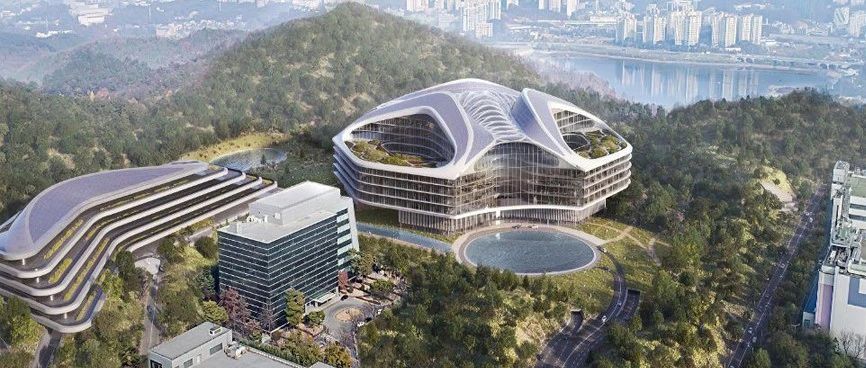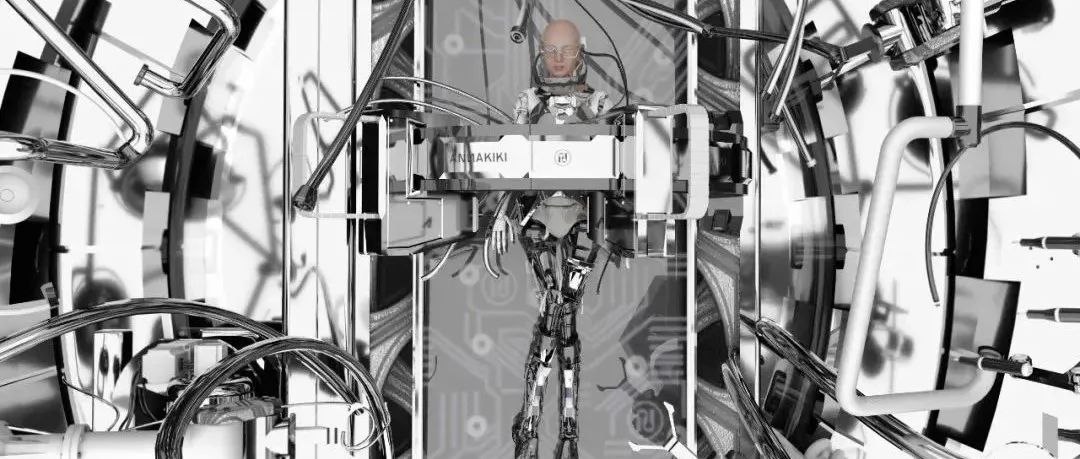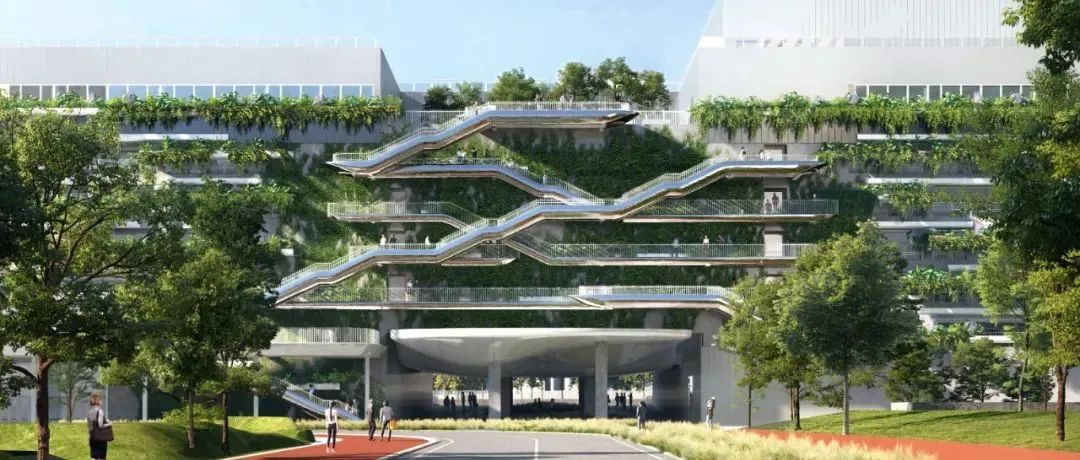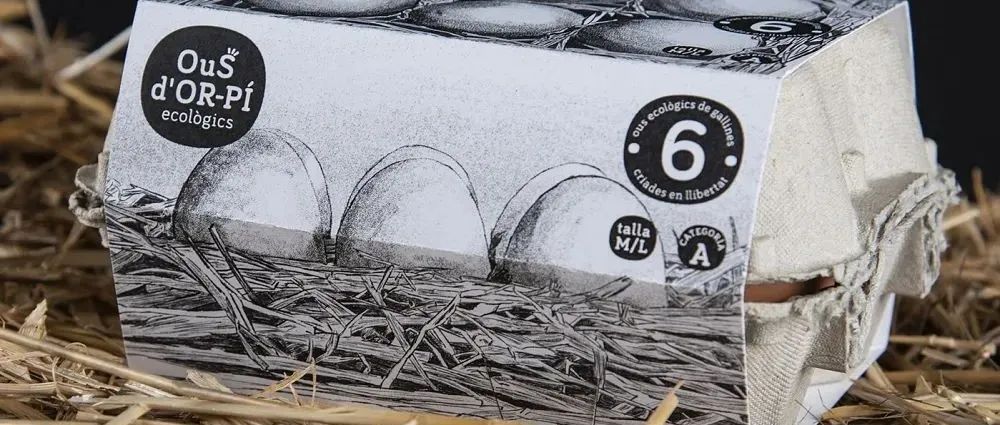保密客户
地点:亚洲
服务:建筑设计,顾问咨询,工程设计,环境健康设计,室内设计,景观设计,规划+城市设计,可持续设计
设计方案将研发综合体坐落在山脉底部空地中的一个月牙形山谷中。它是森林中的一颗明珠。
新的研发综合体与自然融为一体,并以此支持公司推动创新和发明的目标。
建筑、室内、建筑系统和景观组成了一个经典的构图,让使用者感到便捷和舒适。身处在美丽的大自然中,员工们可以放松下来,更有创造性地思考。绝妙的户外景观能够激发他们构思改变世界的创意灵感。
与 环 境 融 为 一 体
建筑的形态和起伏的屋顶景观与周围的山丘协调相融。建筑形态的结构性开口将自然光、空气和景观融入作为基本的设计元素,为使用者提供了直接接触大自然的机会。
结合并辅助主建筑,子研发大楼环拥着周围的山坡。它阶梯式的露台上有植被、花园、小径以及户外座位区,这些都作为自然绿色山坡的延伸。
联 结 10,000 名 创 新 研 究 者
主研发综合体的设计确保了公司员工之间可以密切互动。他们都受益于充足的日光、建筑的开放性,同时能与他们的同事以及户外保持身体上和视觉上的接触。
有效的平面布局规划确保了每张办公桌都在建筑物外缘14米的范围内,让每个人都能看到窗外的风景,并且能用到在建筑物周边的便利设施。人们可以在不到一分钟的时间内从大楼内的一个角落走到另一个角落。
具 有 包 容 性 的 工 作 场 所
团队社区为主导的工作环境策略在大的办公空间内创建微型工作社区,并将每个人与中央便利设施联系起来。
设计创造了一个对神经多样化人士友好的工作场所,并且使来自不同背景的人都能适应其中。员工可以根据工作任务选择他们认为适合自己的工作环境。每个空间针对声学质量、热舒适度和采光都进行了优化,而且都能轻易做到同时适应高敏感度和低敏感度使用者的需求。
科 学 展 示 型
设计挑战了人们对典型科研设施的刻板印象,通过最大限度地提高实验室、办公室和公共区域之间的透明度与整合度,将科学进行“展示”。
面向公众的科技实验室、高科技产品展示以及受科学启发的艺术作品将研究活动融入到建筑设计中。
生 物 仿 生 学
建筑的形态源于对季节变化、太阳位置以及与景观相互作用的反应,更好地呼应了温带阔叶林生物群系。
建筑设计从当地松树林和本土欧亚喜鹊中汲取灵感,再现了当地建筑的风格。松树是当地一个主要的景观元素,它帮助混合针叶落叶林快速生长,并从大气中去除二氧化碳。松树还吸收以及分配整个项目地块的水资源。
为提供自然通风而打开的动态百叶窗控制着中央中庭上方的EFTE面板。它们模仿了喜鹊在飞翔时展开的翅膀可以锁定在原位的特性。喜鹊羽毛中不断变化的彩虹色也为彩色玻璃幕墙提供了灵感。
科 技 生 物 学
LEED白金级设计已为净零能耗做好准备,同时达到了科研型园区的最高可持续性水平。
团队借鉴了项目地的自然智慧和生态系统——森林、草地和水——来创造一个整体性的可持续发展的园区。建筑物周边的生态和建筑物的科技相互配合,相互支持。生物学成为了科学技术。
项目地的可再生能源将提供建筑物预估年度能源使用量的15%。屋顶集成光伏系统与太阳能热板相结合,满足了建筑物的电力和热能需求。
综 合 水 系 统
山上的雨水和融雪在山顶的季节性湖泊中汇聚并流向山谷,从而提供了水源。蓄水池和 "地下河流 "在园区的边缘收集这些山地径流。
这些水与经过处理的废水一起灌溉了周围的森林景观,帮助山谷再生。在这个循环系统中,建筑和生态密不可分。它们相互支持,相互依赖。
地下蓄水池储存了用于灌溉的水。与先进的建筑技术相结合,这些水还提供了热储存和交换储存的来源。它有助于在夏季为建筑物降温。
黑水处理系统、渗透系统以及收集池和蓄水池使该建筑群实现了净零用水。
行 人 优 先
设计优先考虑了行人的安全、舒适度以及路径效率。
所有的员工停车场都在地下,从而实现了无车景观。精心设计的园区规划甚至消除了对小型个人电动车的需求。
设计将开放式楼梯有策略性地布置在了每个建筑的节点处,并沿着中庭设置。
适 应 未 来
设计将公司的用地视为宝贵的资产,将新的主研发中心和子研发大楼设施合并,为未来的发展保留了很大一部分园区用地。通过精心的分阶段施工方法,项目地将满足公司在未来几年内不可预测的需求。
高度灵活的内部空间将协助公司应对未来的改变。
Research Complex Design Competition for Confidential Client
Location: Asia
Services: Architecture, Consulting, Engineering, Health + Well-Being, Interiors, Landscape Architecture, Planning + Urban Design, Sustainable Design
The design nestles this R&D complex into a crescent-shaped valley in a clearing at the base of a mountain range. It’s a jewel in the forest.
Blending the new R&D complex into the natural world supports the company’s goal of driving discovery and innovation.
The architecture, interiors, building systems and landscape work together as a timeless composition to put employees at ease. Surrounded by nature, they can relax and think more creatively. The stunning outdoor landscape inspires them as they conceive ideas for changing the world.
At One with the Environment
The form and undulating roofscape are in harmony with the surrounding hills. Structured openings in the building form incorporate light, air and the landscape as essential design elements, offering occupants direct access to nature.
As a companion to the main complex, the sub R&D building embraces the hillside from which it has emerged. Its stepped terraces are landscaped with vegetation, gardens, paths and outdoor seating areas that act as extensions of the natural green hillside.
Connecting 10,000 Innovators
The design of the main R&D complex ensures that the company’s people are connected. They all benefit from ample daylight, openness, and physical and visual access to their colleagues and outdoors.
The efficient plan ensures that every desk is within 46 feet of the building’s perimeter, giving everyone access to views outside and the amenities placed around the building perimeter. People can walk around the outer perimeter of the building—from corner to corner in every direction—in less than a minute.
Inclusive Workplace
The strategy of providing neighborhood-based environments creates micro communities within the larger floor plates and connects everyone with central amenities.
The design creates a neurodiverse-friendly workplace that enables people from diverse backgrounds to thrive. Employees can choose their appropriate work environments for each task. Spaces are optimized for acoustic quality, thermal comfort and daylighting. They can easily adapt to the needs of both hypersensitive and hyposensitive occupants.
Science on Display
The design challenges preconceived notions of a typical scientific research facility, putting science “on display” by maximizing transparency and integration between labs, offices and public spaces.
Public-facing technology labs, high-tech product displays, and science-inspired artwork blend the research activities into the building design.
Biomimicry
Responding to the temperate broadleaf forest biome, the architecture derives its form from a response to the changing seasons, position of the sun and interactions with the landscape.
The building design takes cues from the native pine forest and the indigenous Eurasian magpie, emulating the local architectural vernacular. Pine trees are a primary landscape element that helps the mixed conifer deciduous forest grow quickly and removes carbon dioxide from the atmosphere. These pines also absorb and distribute water across the site.
Dynamic louvers that open to provide natural ventilation control the EFTE panels above the central atrium. These emulate the magpie, which has wings that lock in place as they spread and open. The changing, iridescent colors found in magpie feathers also informed the colors of the dichroic glass facades.
Biology as Technology
The LEED Platinum design is net-zero ready. It attains the highest level of sustainability for research campuses.
The team borrowed from the natural intelligence and systems of the site—the forest, meadows and water—to create a holistic sustainable campus. The ecology of the site and the technology of the buildings interface with and support each other. Biology becomes technology.
On-site renewable energy will generate up to 15 percent of the building’s predicted annual energy use. A roof integrated PV system is coupled with solar thermal panels to satisfy the building’s electric and thermal demands.
Comprehensive Water Systems
The mountain provides water through rain and snowmelt that collects in seasonal lakes at the top of the hill and runs down into the valley. Retention ponds and ‘underground rivers’ capture this mountain runoff at the edge of the campus.
This water, along with treated wastewater, irrigates the surrounding forest landscape, helping to regenerate the valley. In this circular system, the building and the site are inextricably linked. They feed off and rely on each other.
Underground basins store water for irrigation. Paired with advanced building technologies, this water also provides sources of thermal storage and exchange storage. It helps cool the buildings in the summer.
A blackwater treatment system, infiltration system, and collecting pools and cisterns position the complex to achieve net-zero water use.
Pedestrians First
The plan prioritizes pedestrian safety, comfort and efficiency.
All employee parking is underground, allowing for a car-free landscape. The carefully designed campus plan eliminates the need for even small personal electric vehicles.
Open staircases are strategically located at nodes within each of the building pavilions, as well as along the atriums.
Resilient for the Future
The design treats the company’s land as a precious asset. Consolidating the new main R&D center and sub R&D facility preserves a large portion of the campus site for future development. With a carefully phased construction approach, the site will accommodate needs the company cannot predict for years to come.
The highly flexible interior space will allow the company to adapt to whatever the future brings.
本文来自微信公众号“HOK贺克”(ID:hok_ap)。大作社经授权转载,该文观点仅代表作者本人,大作社平台仅提供信息存储空间服务。












